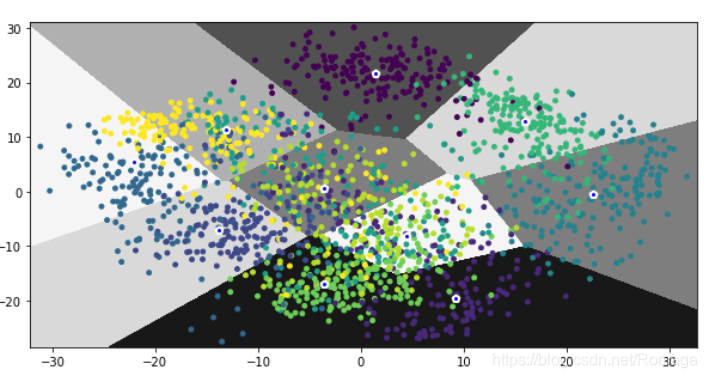-
主成分分析
-
PCA降维
Notes: -
KNN(K-NearstNeighor)有监督算法(近邻个数);
-
KMeans无监督算法(最终聚类的个数/分成K类)
-
决策边界:
-
datasets:
- 数据集载入 :load_digits()
- .data / .target / .target_names
- .images:张数1792 X 每张尺寸(8X8)
- 数据集载入 :load_digits()
-
PCA降维:
- fit_transform()返回降维后的数据
- fit()仅 返回模型参数
-
可视化:
- 灰度图:plt.imshow(image,cmap=plt.cm.gray_r)
手写数字识别聚类:
#手写数字数据集 1797张 8X8 from sklearn import decomposition from sklearn.cluster import KMeans digits_data = datasets.load_digits() #载入数据集 X = digits_data.data #X.shape=>(1797,64) y = digits_data.target #降维 estimator = decomposition.PCA(n_components=2) reduce_data = estimator.fit_transform(X) #训练 model = KMeans(n_clusters=10).fit(reduce_data) #坐标网格矩阵 x_min,x_max = reduce_data[:,0].min() -1,reduce_data[:,0].max() +1 y_min,y_max = reduce_data[:,1].min() -1,reduce_data[:,1].max() +1 xx,yy = np.meshgrid(np.arange(x_min,x_max,.05),np.arange(y_min,y_max,.05)) #预测,结果可视 result = model.predict(np.c_[xx.ravel(),yy.ravel()]) result = result.reshape(xx.shape) plt.figure(figsize=(10,5)) plt.contourf(xx,yy,result,cmap=plt.cm.Greys) plt.scatter(reduce_data[:,0],reduce_data[:,1],c=y,s=15) center = model.cluster_centers_ plt.scatter(center[:,0],center[:,1],marker='p',lw=2,color='b',edgecolors='w',zorder=20) plt.xlim(x_min,x_max),plt.ylim(y_min,y_max)

评估:
- 随机森林分类
- 交叉验证(cv = 5)
from sklearn.ensemble import RandomForestClassifier
from sklearn.model_selection import cross_val_score
estimator = decomposition.PCA(n_components=5) # 从 10 个特征缩减为 5 个特征
X_pca = estimator.fit_transform(X)
model = RandomForestClassifier()
cross_val_score(model,X,y,cv=5).mean()
总结: 原始数据集PCA降维(/数据预处理)-聚类
来源:CSDN
作者:啊嘞随便什么昵称都可以
链接:https://blog.csdn.net/Romaga/article/details/104718747